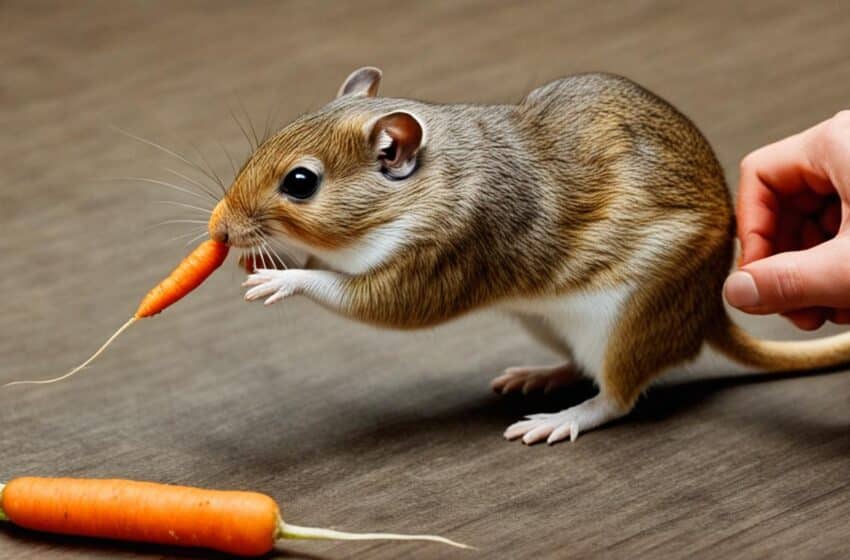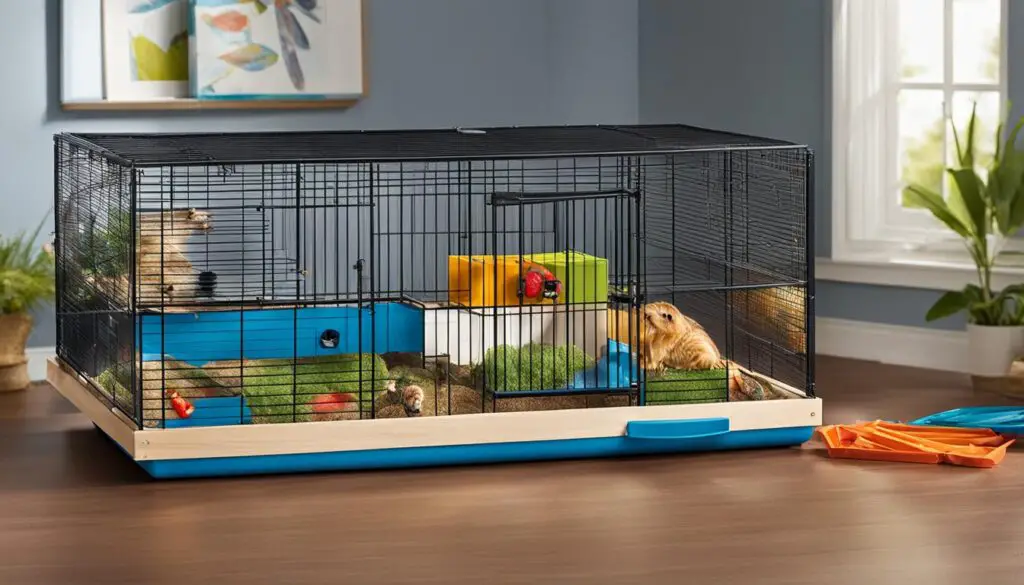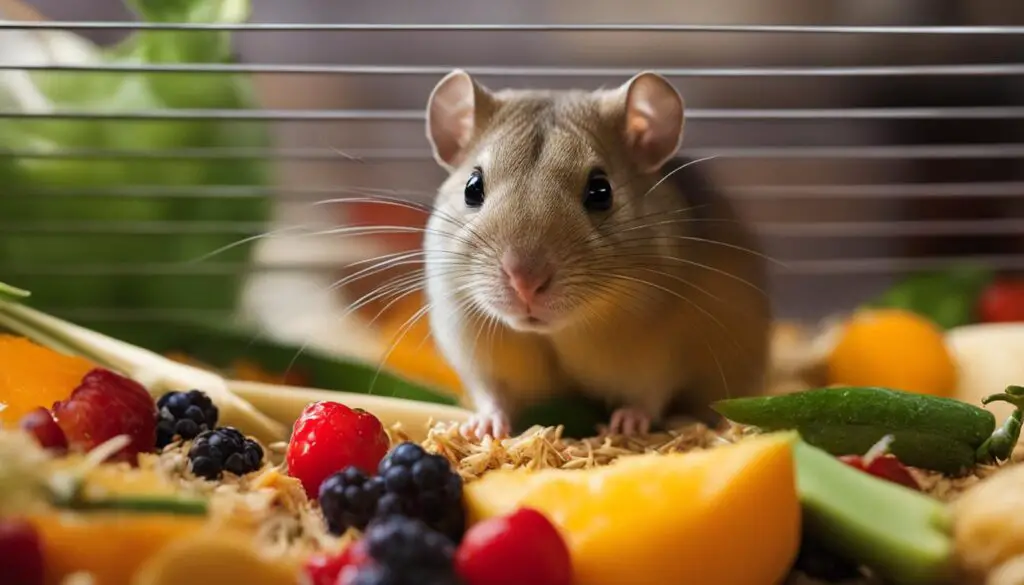How to Introduce New Foods to Your Gerbil’s Diet

Introducing new foods to your gerbil’s diet can be a rewarding and important part of their overall well-being. As a responsible pet owner, I understand the significance of a healthy diet expansion for my furry friend. However, it’s crucial to approach this process with caution to ensure that your gerbil stays healthy and safe.
Key Takeaways:
- Gradually introduce new foods to your gerbil’s diet to prevent any digestive issues or allergies
- Understand your gerbil’s dietary needs, including the importance of commercial pelleted food and occasional treats
- Provide a secure and appropriately sized cage with toys and chew items for mental stimulation
- Maintain a clean and healthy environment by choosing safe bedding and regular cage cleaning
- Monitor your gerbil’s response to new foods and consult a veterinarian for any concerns or questions
Understanding Your Gerbil’s Dietary Needs
Before introducing new foods to your gerbil’s diet, it’s crucial to understand their dietary needs. Gerbils require a balanced and nutritious diet to thrive and stay healthy. By providing the right combination of foods, you can ensure that your furry friend receives all the necessary nutrients.
Gerbils benefit from a diet that includes a commercial pelleted food with seed products or seeds as the main ingredients. These pellets are specifically formulated to meet their nutritional requirements and provide essential vitamins and minerals. Look for high-quality brands that prioritize the well-being of small pets. Avoid foods that contain high amounts of grains, as gerbils have difficulty digesting them.
Tip: As a responsible pet owner, it’s crucial to avoid overfeeding your gerbil. Feed them small meals throughout the day instead of a large, single portion. This mimics their natural foraging behavior and helps keep them active and engaged.
While commercial pelleted food forms the foundation of a gerbil’s diet, it’s also essential to include fresh foods as occasional treats. Some safe fruits and vegetables to offer include:
- Apples (remove the seeds)
- Pears
- Carrots
- Cucumbers
- Bell peppers
Caution: Always introduce fresh foods gradually to avoid digestive upsets. Start by offering small pieces alongside their regular diet, and monitor your gerbil for any adverse reactions or allergies. Fresh foods should only make up a small portion of their overall diet.
Gerbils are natural foragers, and providing them with interactive treat dispensers can stimulate their foraging behavior. These toys require the gerbil to work for their food, keeping them mentally and physically active.
| Fruits | Vegetables |
|---|---|
| Apples | Carrots |
| Pears | Cucumbers |
| Berries | Bell peppers |
Introducing New Foods Gradually
When it comes to introducing new foods to your gerbil, a gradual approach is key. This allows their digestive system to adjust and minimizes the risk of potential allergies or digestive issues. Here are some expert tips to help you ensure a smooth transition.
Start Small
Start by offering small pieces of the new food alongside their regular diet. This allows your gerbil to sample the new food without overwhelming their digestive system. Gradually increase the portion size over time as they become accustomed to it.
Monitor for Allergies
Keep a close eye on your gerbil for any signs of allergies. Watch out for symptoms such as itching, redness, or difficulty breathing. If you notice any adverse reactions, remove the new food from their diet and consult a veterinarian.
Safe Foods to Introduce
When introducing new foods, opt for safe options that are less likely to cause digestive issues. Fresh leafy greens and root vegetables are usually well-tolerated by gerbils. However, always remember to cut fresh foods into small, manageable pieces to prevent choking or intestinal blockage.
Expert Tip: A gradual introduction of new foods minimizes the risk of potential allergies and digestive issues, ensuring the health and well-being of your gerbil.
Sample Table of Safe Foods for Gerbils
Choosing the Right Cage and Accessories
Providing your gerbil with a secure and appropriately sized cage is essential for their well-being. Gerbils need a minimum of 450 square inches of floor space, and if you have multiple gerbils, aim for 900 square inches.
When selecting a cage, choose one that not only meets the size requirements but also provides a secure environment. Gerbils are known to be escape artists, so make sure the cage has a secure cage door and sturdy construction.
Add tubes and levels to the cage to give your gerbil plenty of opportunities to explore and exercise. Gerbils love to climb and burrow, so providing them with different levels and tunnels will keep them entertained and mentally stimulated.
To keep your gerbil active, it’s important to provide a variety of toys and accessories. Hideouts and tunnels will give your gerbil a sense of security and a place to retreat to when needed. Additionally, gerbils have a natural instinct to chew, so be sure to include chew toys in their cage. Chew toys help wear down their continuously growing teeth and prevent dental problems.
A hamster wheel is another essential accessory for your gerbil’s cage. Gerbils are active animals and need a way to burn off excess energy. A hamster wheel provides them with an outlet for exercise and helps promote physical well-being. Make sure to choose a wheel that is appropriately sized for your gerbil and has a solid running surface to avoid any potential injuries.
Remember, providing a secure cage with ample space and a variety of toys and accessories will contribute to your gerbil’s overall happiness and well-being.
Tips for Choosing the Right Cage and Accessories:
- Ensure the cage is secure and has a sturdy construction.
- Choose a cage with tubes and levels for exploration.
- Include hideouts and tunnels for your gerbil’s sense of security.
- Provide chew toys to promote dental health.
- Select an appropriately sized hamster wheel for exercise.

Maintaining a Clean and Healthy Environment
Keeping your gerbil’s cage clean is crucial for their health and well-being. A clean environment helps prevent the buildup of bacteria, parasites, and odors that can harm your gerbil. Regular cleaning not only ensures a safe living space but also promotes respiratory health and overall happiness.
Here are some essential tips for maintaining a clean and healthy environment for your gerbil:
The Importance of Cleaning
Regular cleaning of your gerbil’s cage helps eliminate germs, bacteria, and odor-causing substances. It is especially crucial for small animals that are sensitive to respiratory problems. A dirty and unhygienic living space can lead to respiratory issues, skin irritations, and even infections.
Spot Cleaning
Perform regular spot cleaning by removing soiled bedding in designated toileting areas. Spot cleaning involves removing waste, uneaten food, and soiled bedding using a small scoop or spoon. This helps maintain a clean and comfortable habitat for your gerbil. Spot clean the cage at least once a day or as needed.
Thorough Cleaning
In addition to spot cleaning, it’s essential to perform thorough cage cleaning every 15 days. Thorough cleaning involves removing all the old bedding, food dishes, and accessories from the cage. Wash them with mild soap and water, rinse well, and dry thoroughly before placing them back in the cage.
Your gerbil will need a temporary home during the cleaning process. Use a small cage or container where your gerbil can stay comfortably until their regular cage is clean and dry.
Choosing Safe Bedding
Choosing the right bedding is crucial for your gerbil’s respiratory health. Opt for bedding that is dust-free, soft, absorbent, and non-toxic. Good options include paper-based bedding or Aspen bedding.
Avoid using cedar wood chips, as they can release aromatic oils that can harm your gerbil’s respiratory system. Similarly, stay away from pine shavings and scented bedding, as they can also cause respiratory problems and liver damage.
Preventing Allergies and Respiratory Problems
Gerbils are prone to allergies and respiratory issues, so it’s essential to provide them with a clean and dust-free environment. Regular cleaning and proper bedding choices help minimize the risk of these problems and promote a healthy living space for your furry friend.

| Cleaning the Cage Checklist | Frequency |
|---|---|
| Spot Cleaning (removing waste, uneaten food, and soiled bedding) | Once a day or as needed |
| Thorough Cleaning (removing all bedding, food dishes, and accessories) | Every 15 days |
Conclusion
Introducing new foods to your gerbil’s diet is an exciting and beneficial endeavor that can contribute to their overall well-being. By following a few key steps, you can ensure a safe and healthy diet expansion for your furry friend.
First and foremost, understanding your gerbil’s dietary needs is essential. Providing a balanced diet that includes a commercial pelleted food with seed products and offering certain fruits and vegetables as occasional treats will help meet their nutritional requirements. Remember that gerbils are natural foragers, so offering small meals throughout the day and using interactive treat dispensers can keep them engaged and active.
When introducing new foods, it’s important to do so gradually. Start by offering small pieces of the new food alongside their regular diet. Monitor your gerbil for any signs of allergies or digestive issues. Introduce safe foods such as fresh leafy greens and root vegetables, while ensuring they are cut into small pieces to prevent choking or intestinal blockage.
In addition to a healthy diet, providing a secure and stimulating cage is crucial. Choose a cage that offers enough space for your gerbil to explore and consider adding toys, accessories, and chew toys to keep them entertained. A hamster wheel is also essential to provide exercise and mental stimulation.
Lastly, maintaining a clean environment is paramount to your gerbil’s well-being. Clean the cage regularly by spot cleaning soiled bedding in toileting areas and thoroughly cleaning the cage every 15 days. Use dust-free, soft, and absorbent bedding that is safe for your gerbil’s respiratory system and avoid cedar wood chips, pine shavings, and scented bedding.
By following these guidelines, you can introduce new foods to your gerbil’s diet, expand their healthy eating options, and ensure they thrive in a clean and stimulating environment. Remember to monitor their response to new foods and consult a veterinarian if you have any concerns or questions.
FAQ
How do I introduce new foods to my gerbil’s diet?
To introduce new foods to your gerbil’s diet, start by offering small pieces of the new food alongside their regular diet. Monitor your gerbil for any signs of allergies or digestive issues. Gradually increase the amount of new food over time.
What are the dietary needs of gerbils?
Gerbils benefit from a diet that includes a commercial pelleted food with seed products or seeds as the first few ingredients. It’s important to avoid foods with high amounts of grains and only provide certain fruits and vegetables as occasional treats. Gerbils are natural foragers, so offering small meals throughout the day and using interactive treat dispensers can help keep them active and engaged.
How should I choose the right cage and accessories for my gerbil?
Provide your gerbil with a secure and appropriately sized cage that has tubes or levels for them to explore and enjoy. Add toys and accessories that allow your gerbil to hide, burrow, and stay active. Make sure to include chew toys as gerbils’ teeth continuously grow. A hamster wheel is also recommended for exercise.
How do I maintain a clean and healthy environment for my gerbil?
Use a small cage or container to temporarily house your gerbil while cleaning the cage. Regularly spot clean soiled bedding in designated toileting areas and thoroughly clean the cage every 15 days. Choose bedding that is dust-free, soft, absorbent, and non-toxic. Avoid cedar wood chips, pine shavings, and scented bedding to prevent respiratory problems and liver damage.
Can introducing new foods to my gerbil’s diet be beneficial?
Yes, introducing new foods to your gerbil’s diet can be a positive and enriching experience for both you and your furry friend. By understanding their dietary needs, introducing new foods gradually, providing a secure and stimulating cage, and maintaining a clean environment, you can ensure a safe and healthy diet expansion for your gerbil.



